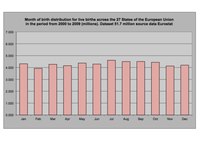
Photo from wikipedia
BackgroundStudies conducted mainly in high-income countries have shown that preterm births are associated with increased risk of behavioral problems and psychiatric disorders. The aim of this study was to assess… Click to show full abstract
BackgroundStudies conducted mainly in high-income countries have shown that preterm births are associated with increased risk of behavioral problems and psychiatric disorders. The aim of this study was to assess the prevalence of behavioral problems from middle-childhood to early-adolescence according to gestational age at birth in a middle-income setting.MethodsA population-based birth cohort (n = 4231) in Pelotas, Brazil, was followed-up in several occasions from birth to 11 years. Estimated GA was based on last menstrual period or, when unknown or inconsistent, on the Dubowitz method. Behavioral problems were assessed at 4 (Child Behavior Checklist - CBCL), and at 6 and 11 years (Development and Well-Being Assessment - DAWBA) tool. Maternal socio-economic characteristics and depression at 2, 4 and 6 years post-partum, child perinatal characteristics and breastfeeding duration were used as confounders. Analyses were run by linear and logistic regression.ResultsThree thousand two hundred four children had full information on gestational age, CBCL and DAWBA. At 4 years, mean total (42.9 ± 24.0) and mean externalizing (18.8 ± 9.1) CBCL scores were higher among preterm girls born at <34 weeks than among full term girls (33.2 ± 15.1 and 15.0 ± 6.6, respectively). After controlling for confounders the association was no longer significant. At the age of 6 years there was no association between gestational age and behavior, neither in crude nor in adjusted analyses. Odds ratio for any psychiatric disorders at 11 years was 60% (1.6; 1.1–2.1) higher among those born at 34–36 weeks than in full-term children, but the association disappeared in adjusted analyses.ConclusionAt this large cohort, behavioral problems from middle-childhood to early-adolescence are more related to family socio-economic characteristics and to other child perinatal conditions than to gestational age at birth.
Journal Title: BMC Pediatrics
Year Published: 2017
Link to full text (if available)
Share on Social Media: Sign Up to like & get
recommendations!